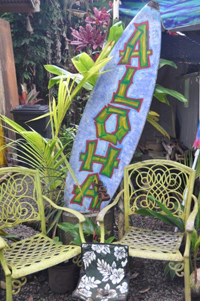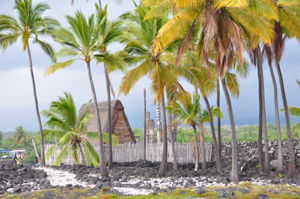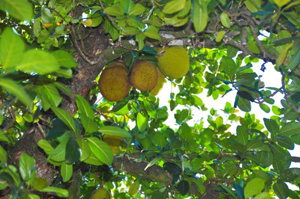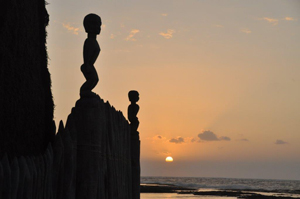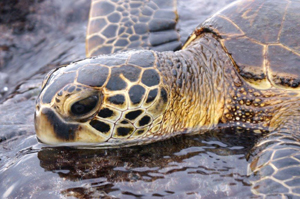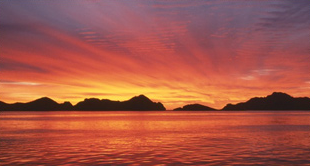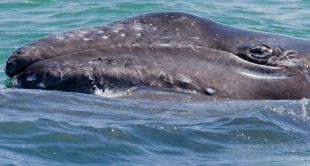Finding modern concepts in old traditions
It is definitely so that worlds collide on the 9 Hawaiian Islands. For instance when planning to set up a new 30m telescope, scheduled for 2024, on top of Mauna Kea, the highest mountain on Hawaii’s Big Island – next to the 13 already existing telescopes.
With the Thirty Meter Telescope (TMT) a new era is supposed to begin for a better quality of sky watching in the close and medium infrared area. The costs: one billion dollar – only. The involved countries are the USA, Japan, Canada, India and China. The main mirror will be composed by 492 single pieces and shall make even sharper pictures than the “Hubble” Space telescope.
The sparkling of the nocturnal firmament is not only a highlight for all the newly married lovebirds during their honeymoon and other tourists but especially for astronomy experts and scientists. The islands are the perfect spot for admirer of the stars and scientific activities. This is due to their location as the islands with the biggest distance from the mainland on the whole planet. Additionally, they really try to keep the light pollution as small as possible.
Humble moments on the highest mountain on earth
As we can tell from our own experiences and journeys, the starry sky is overwhelming, the gates to different galaxies are getting closer and closer to ones grasp and the constellations become vivid in the night sky.
Due to our interest and the immersion in the Hawaiian culture we also know, why the highest mountain on earth, this Mauna Kea, is sacred to them. For them it is a holy place, a place of power – Hawaiians go to this 4200m high summit to strengthen their spiritual power (Mana) or, to express it differently, to get closer to the divine. Standing on top of the mountain, e.g. at sunset, it takes one’s breath away because of the transcendence and beauty of this place. Simply breathtaking.
The people and Kahunas (Hawaiian shamans/wise man) that we got to know personally, fight with all their strength against the commercial use of this sublime place. It touches them deeply, how nature and their sacred sites are treated. Their pain is obvious and not rarely they shed tears. Continuously they perform rituals and ceremonies to maintain their sacred land.
Another Kumu (teacher) on Big Island turns toward the whole situation with a superior vision – both sides shall be respected and a corporate solution shall be found to create a Win-Win situation.
The native people – a maritime nation once coming from Tahiti and the Marquesas, following the lead of the stars – lived many decades in unison with themselves, the world and, above all, the existing resources.
Yet, as everywhere when it is time for enhancements, external influences came into play… – with the “new world – conquistadors” and whalers, missionaries from America came to rescue the savage primitive people. Rescue of what or from who is unknown until now.
Hostess gifts are not always appropriate
Sure, the missionaries brought the alphabet and a few pretty useful improvements as well as God, not acknowledging that there are already many existing gods that have done a pretty good job so far.
The four Hawaiian gods are Kane, Ku, Lono and Kanaloa. Kane is the god responsible for the sunlight, fresh water and natural life. Ku is the god of war and the power of man. Lono is god of peace, fertility, sports (surfing has been invented in Hawai’i) as well as the power of wind and rain and last but not least, Kanaloa is the god of the ocean. Surely, the highly respected pearl – the fire goddess and sovereign of the volcanoes and lava -Pele is not supposed to miss, who is fondly called “Tutu” (Grandma).
The widely travelled brought devastating hosts gifts with them. Amongst others various infectious diseases (Tuberculosis etc.) mostly transmitted by the whale hunters who couldn’t think of anything else than women and alcohol after spending months of seafaring. The immune system of the Hawaiian population had no capability to defend itself against this attack. 800.000 natives (98% of the population) died as a consequence. Extrapolations predicts that in 2044 there won’t be any native Hawaiians left, whose roots point explicitly to the Polynesian ancestors.
Little by little, the island became a multicultural melting pot. 1810 King Kamehameha united the earlier separately reigned islands to one kingdom. 1815 the Russians tried to gain ground on Kauai: it remained a try.
In 1830 the first sugar cane plantations were set up and with that, the immigration to the green, isolated islands started with people coming from all over the world: from China to Norway, the contemporary multicultural population has its roots from all over the world. 1893 the last Hawaiian queen Liloukalani had to back out, due to a putsch of the Americans. America identifies the islands as an important strategic base, especially during the Second World War, which results in the recognition as the 50th federal state of the United States on 21th of August 1959.
Breathless through the day
I am pretty sure, the Hawaiian goddesses judged this actions in a very depreciating way. What a pity about the Hawaiian language, whose alphabet has only 12 characters: vocals: A, E, I, O, U and consonants: H, K, L, M, N, P, W. For us Europeans this melodic language is much easier to pronounce since we pronounce an A as an A as it is done in the Hawaiian language too, whereas the Americans pronounce the A as “ey”.
The language reflects the connection to the nature and has mostly pretty appropriate denomination/description: e.g. Haole – that’s the name for us people from the west – are those, who just breathe halfway, hence are always in a rush.
Or Aloha… a very simple, yet so meaningful word:
A: akahai: modest, observing, awake
L: lōkahi: unity, harmony
O: ‘oia’i’o: honest, sincere and also friendly
H: ha’aha’a: humble
A: ahonui: patient, persistent
It is easy recognizable on the islands: Aloha is e.g. the unconditional goodwill in the air towards strangers – completely the contrary to the shallow “How are you today?” (Which doesn’t even expect an answer) of the mainland Americans.
Nobody is forgotten or stays behind
How good that there are people who stand up for the maintenance of the precious Hawaiian cultural assets and even take a step beyond, to live and reactivate it (www.olohanafoundation.org). By now, there are 23 schools at Hawai’i that teach the Hawaiian language again. There are numerous Hula-schools and a growing interest in not seeing it only as a touristic attraction but as new concepts anchored in old traditions; as precious, worth to be kept cultural asset, based on the roots of a nation that mainly is and was one thing: connected and consistent with nature. This also implies the word Ohana. Ohana means family.
For Hawaiians the word family means: nobody is forgotten or left behind. The meaning derives from the Taro plant (a potato-like fruit that holds a lot of starch and grows on Hawai’i in knee-deep waters). Taro is a Hawaiian staple food and stands for the source of being, the spring itself and the contact to the ancestors. Not for nothing the word Ohana comes from the small offshoots of the tuber, the small OHANAS. Everything of this plant is eatable. Very tasty these spinach-like leaves.
In one of the national parks we met a Hawaiian who showed traditional craftsmanship to the park visitors and tourists. He talked to several of the people while neatly pursuing his skills. I didn’t dare to take pictures of the tanned, half naked man with the typical dark, profound eyes of the native Hawaiians and/instead observed the scene and listened….
The Hawaiian was telling: “We, the Hawaiians, know and we always knew. We have to take care of the resources: the water, the plants, and the air – the planet. First thing: resources, it is the base and then comes Ohana, the family”.
The implicitness of how he was saying this really touched me and blew me off my feet. I really could feel that he meant it like he said it – that this understanding is cellular, that his ancestors had this deep knowledge and really lived it then and are partly living it still today. If you then also know how important the family and the ancestors are in the Hawaiian culture. The last I in the word Hawai’i represents those ancestors. They are honored and well-considered. They smoothed the way. And I am sure they will turnover in their graves when hearing about the behavior of one of the biggest companies worldwide, namely Monsanto and see, what is currently happening.
Just after the whole island of Maui decided in a referendum in favor of staying a completely genetic engineering –free zone, hence deciding against Monsanto, Monsanto sues them. Hello? There you can just ask the simple questions: Seriously?
Flying to the oldest island Kaua’i – a beautiful, floating garden. A landscape that ecstasies. Even here they experiment with genetic engineering. The locals are furious about that and united to fight the obviously ethic-free Goliath Monsanto. We have been to an event, favoring a GMO free Kaua’i during which the guest speaker Dr. Vandana Shivananda issued a very strong statement: she would only come back if the garden island kicks out Monsanto. GMO no!
Coconut and Breadfruit
The inhabitants of the island agitate to that and are very confident that it will be possible to kick out Monsanto, according to Uncle Nelson from Kaua’i. Older people prefer to be referred to as “uncle” and “auntie”, to show respect. A behavior that always touches me in my heart because it is a matter of fact that on these islands, elderly are treated respectfully and ancestors never vanish from their consciousness. According to my opinion, we could definitely take a leaf out of their book…
So Uncle Nelson climbs with his 70 years light-footed the palm tree, to pick the meaty nuts from this tree of live. Willingly he speaks about them in an entertaining way and lets us try them: it really does make a difference if the coconut is grated or trimmed. If you believe it or not, indeed it is.
The coconut is not growing everywhere, but at the places where it does, it could assure the survival of many people – also in situations of need. Thus, it is much better to know how to open them and how to use the single parts of it. From the coconut to the breadfruit. The most kinds of breadfruit can be found in the Breadfruit Institute on Hawai’i. At this place they do research to find multiplication methods for this yielding tree. The huge tropical tree grows big, green, starchy fruits which, however, don’t taste good when ate raw but can be prepared like potatoes – or you wait until the fruit is completely ripe because then the sweet flesh is also raw enjoyable.
This tree could be an answer to the increasing prices of food on the world market. The Kanu plant (in the 12th century it was taken on boats to be planted in newly discovered islands) enables a sustainable and regional supply in the tropical countries. Not everything from the earlier days is useless: old traditions become new-age concepts.
Hawai’i is diverse, disputed and everything uniting. The visit in one of the big hotels at a beautiful beach where the Humpback whales are jumping, is for sure very restorative. However, Hawai’i is so much more than Hula, rainbows, beaches and waterfalls.
The spectrum of the nation that respects the nature has a wide variety: reaching from an ancestor respecting and resource conserving culture to a sense of community and sweet, melancholic Ukulele music to strong rituals of absolution.
It makes sense to see behind the touristic curtain and to dive in and descend to the roots of the Hawaiians. We are determined that one can bring some shimmering pearls up when emerging, being thought-provoking and maybe inspiring for the own life in a sustainable way – at least that’s our experience.
I must go now, I need to book the flights for our next Hawai’i journey in January 2016 and don’t have time anymore, which I’ll maybe find, once I am back on Hawai’i:
You have the clock and we, the Hawaiians, have the time (Hawaiian proverb).
Aloha!





